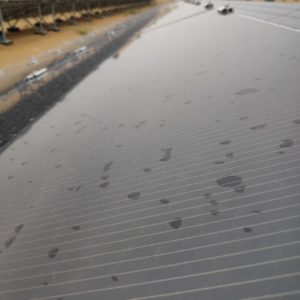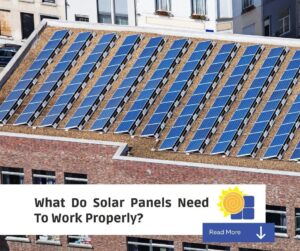Many people think that higher temperatures on the solar panels make them produce more electricity. Is this true, or is it yet another Solar Energy myth? If you ask anyone – who is relatively new or has no idea yet – about the effects of heat on solar panels, then you will be told 2 things:
- Sun’s heat can increase the power output of solar panels.
- The higher the temperature, the more solar energy you can get from a solar module.
Technically, both of these claims are false.
In this article, you’ll learn why that is and what to do about it. But first, the basics…
Does temperature affect solar panels?
Temperature plays very important role in the performance of the solar panels as it affects their power output significantly. Whenever the PV module is already installed in the field, it can collect sunlight and convert the energy into DC electricity.
Its efficiency in pumping solar energy is primarily affected by how hot the solar cells become while being exposed to sunlight. Now, what about if there’s a solar eclipse happening? You may want to read our article about solar panel performance during an eclipse here in case you’re interested.
As we all know, solar panels are the rectangular-shaped modules that are arranged closely to each other to collect the energy coming from sunlight.
Solar panels, when connected in series, form a photovoltaic string that will supply the DC voltage and current to inverters. This DC power will then be converted into AC – the type of electricity your home appliances use. Furthermore, knowing how solar panels are made will be beneficial, too.
Standard Test Conditions
The Standard Test Conditions (a.k.a. STC) are the conditions wherein solar PV manufacturers rate their solar panel’s power output in Watts. These pertain to the test environment conditions wherein the solar irradiance is 1000 Watts/sq.m.; the solar CELL temperature is 25°C, and there is no wind. Air Mass is 1.5.
How Does Temperature Affect The Solar Panel Output?
Heat definitely reduces the output voltage and power of a solar panel. Now, let us discuss how that happens.
If you check the specifications sheet or the nameplate of a solar panel, it will show you the temperature coefficient factors of the module. They are the following:
- Temperature Coefficient of Maximum Power.
- Temperature Coefficient of Open-Circuit Voltage.
- Temperature Coefficient of Short-Circuit Current.
These factors determine how the solar panel’s output power, voltage, and current are affected, as the cell temperature changes above or below 25℃ (the temperature at Standard Test Conditions or STC).
We have an informational table below that shows us the 10 most popular and most efficient solar panels with their Temperature Coefficient data. This will help us understand more about the relationship between the temperature and solar panel outputs.
| Make | Model | Efficiency | Temperature Coefficient of Maximum Power | Temperature Coefficient of Open-Circuit Voltage | Temperature Coefficient of Short-Circuit Current | |
| 1 | SunPower | Maxeon 3 | 22.60% | -0.29 %/°C | -0.234 %/°C | 0.044 %/°C |
| 2 | LG | Neon R | 22.00% | -0.30 %/°C | -0.24 %/°C | 0.04 %/°C |
| 3 | REC | Alpha | 21.70% | -0.26 %/°C | -0.24 %/°C | 0.04 %/°C |
| 4 | Jinko Solar | Tiger 7RL3 | 20.93% | -0.35 %/°C | -0.28 %/°C | 0.048 %/°C |
| 5 | Longi Solar | Hi-Mo 4 | 20.90% | -0.35 %/°C | -0.284 %/°C | 0.05 %/°C |
| 6 | Phono Solar | TwinPlus M4-9B-R | 20.80% | -0.38 %/°C | -0.30 %/°C | 0.05 %/°C |
| 7 | Trina Solar | Honey M DEO8 | 20.50% | -0.36 %/°C | -0.26 %/°C | 0.04 %/°C |
| 8 | Solaria | Power XT | 20.50% | -0.39 %/°C | -0.29 %/°C | 0.04 %/°C |
| 9 | Canadian Solar | HiDM CS1H-MS | 20.50% | -0.37 %/°C | -0.29 %/°C | 0.05 %/°C |
| 10 | Q cells | Q.Peak DUO G8+ | 20.10% | -0.35 %/°C | -0.27 %/°C | 0.05 %/°C |
Based on the data presented above, we will see that the average Temperature Coefficients for maximum power, open-circuit voltage, and short-circuit current are -0.34 %/°C, -0.2688 %/°C, and 0.0452 %/°C respectively.
As The Temperature Rises, Solar Panel Output Wattage Reduces
From what we can observe from the table, the factor relating to the maximum power and temperature change is a negative number. This means that for every degree Celsius increase from 25°C STC temperature of the PV cell, the solar panel power output will be reduced by some percentage.
Only the module’s output current gains a little bit of increase but it is still considered negligible. This is why the power output of a solar panel decreases along with the rise of cell temperature.
Additionally, the voltage drop on the PV cables increases as the temperatures go higher.

How To Calculate Solar Panel Output Power Loss Due To Temperature
For example, let us say that the heat of the surrounding environment causes the solar cell’s temperature to reach 60°C. This means it has increased by 35 units from the STC. Now, let’s say that the module is a 400Watt solar panel with a -0.29 %/°C Temperature Coefficient of Maximum Power.
In which,
α = Temperature Coefficient of Maximum Power, or -0.34 %/°C
T_new = solar cell’s new temperature, or 60°C
T_STC = solar cell temperature at STC, or 25°C
T_diff = temperature difference between T_new and T_STC
P_max = solar module’s rated output power, or the given 400W
P_change = solar panel’s rate of change in Watts per °C, or (P_max) x (α)
P_new = solar panel’s output power at T_new, or P_max + (P_change) x (T_diff)
Then,
P_change = (P_max) x (α)
P_change = (400W) x (-0.34 %/°C)
P_change = (400W) x (-0.0034 /°C)
P_change = -1.36 W/°C
T_diff = T_new – T_STC
T_diff = 60°C – 25°C
T_diff = 35°C
Thus,
P_new = P_max + (P_change)x(T_diff)
P_new = 400W + (-1.36W/°C)x(35°C)
P_new = 400W + (-47.6W)
P_new = 352.4W
Therefore, a 400W solar module will be reduced to 352.4W when the solar cell temperature reaches 60°C. There has been an 11.9% decrease in the PV module’s output power due to the temperature change, 35 units from the 25°C STC. This means, the solar panel efficiency also decreases since the module’s wattage becomes less.
Conclusion
Now that we have done the calculations, we can definitely conclude that more heat on the solar panels will only decrease the power output capacity of the module. Since the PV module’s efficiency depends greatly on its output wattage, it will only go down to a lower value as the temperature of the solar cell becomes hotter. See the effect of installing solar panels as floating solar plants to reduce the effect of high temperatures.
If you like our content, we invite you to follow us on our social media outlets for more updates!
Don’t forget to sign up to our email list today! Be part of the Solar Powered Fam!
References
- https://sunpower.maxeon.com/au/sites/default/files/2019-07/max3-400-390-370-au_0.pdf
- https://www.lg.com/global/business/download/resources/solar/NeonR_60_V5_90812.pdf
- https://www.solarelectricsupply.com/media/custom/upload/REC-Alpha-Series-360-380W-solar-panel-datasheet.pdf
- https://en.longi-solar.com/uploads/attach/20210122/600a478de6635.pdf
- https://static.trinasolar.com/sites/default/files/EN_DE08M%28II%29_datasheet_2020_A_web.pdf
- https://www.solarcrowdsource.com/wp-content/uploads/2020/04/Solaria_370.pdf
- https://www.jinkosolar.com/uploads/5e86a7a6/Tiger%20brochure-EN-P.pdf
- https://static.csisolar.com/wp-content/uploads/2019/12/Canadian_Solar-Datasheet-HiDM_CS1H-MS_EN.pdf
- http://www.phonosolar.com/international/upload/files/2021/1/GL-EN-TwinPlus-166-144-9BB.pdf
- https://www.q-cells.com/dam/jcr:f0be21ec-fd73-4776-bc6e-8d919c5c2d5b/Q_CELLS_Data_sheet_Q.PEAK_DUO-G8+_340-360_2020-01_Rev01_EN.pdf



















good thanks for sharing information